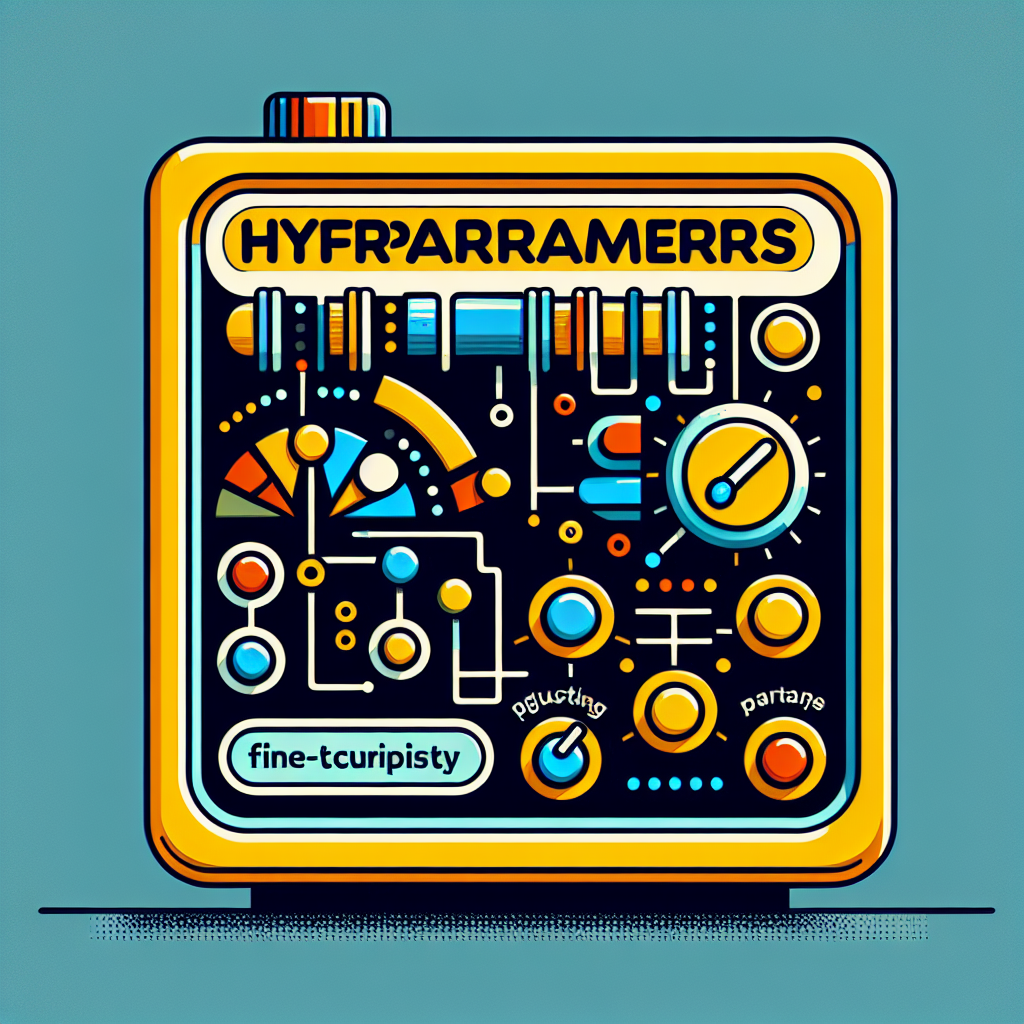In the world of machine learning, the term “hyperparameters” refers to those magical settings that determine how a model learns and predicts. But what exactly are hyperparameters? Essentially, they are the knobs and dials that you, as the mastermind behind the model, get to tweak to optimize its performance. From adjusting the learning rate to fine-tuning the number of hidden layers in a neural network, hyperparameters hold the key to unlocking the full potential of your machine learning algorithm. So, let’s unravel the mystery and demystify hyperparameters together!

Definition of Hyperparameters
Introduction
When it comes to machine learning algorithms, hyperparameters play a crucial role in determining the performance and accuracy of the models. Hyperparameters are essentially the knobs and switches that we can tweak and adjust to optimize our algorithms. Unlike the internal parameters of the model that are learned during training, hyperparameters are set by the user before the training begins. They control various aspects of the learning process, such as the architecture, learning rate, and regularization of the model.
Importance of Hyperparameters
Hyperparameters can significantly impact the performance and efficiency of machine learning models. Selecting appropriate values for hyperparameters can make the difference between a model that performs well and one that fails to learn effectively. By tuning hyperparameters, we can improve the model’s ability to generalize to unseen data, avoid overfitting, and achieve higher accuracy. Therefore, understanding and effectively tuning hyperparameters is essential for successful machine learning applications.
Types of Hyperparameters
Model Hyperparameters
Model hyperparameters are parameters that define the structure and behavior of the machine learning model itself. These parameters are independent of the specific training data and can vary across different models. They include the number of hidden units, the activation function, and the number of layers in a neural network, the maximum depth of a decision tree, or the degree of polynomial features in a linear regression model.
Algorithm Hyperparameters
Algorithm hyperparameters, on the other hand, are the parameters that define the learning algorithm itself. They govern the optimization process and control how the model learns from the data. Examples of algorithm hyperparameters include the learning rate, weight decay, batch size, and the number of training epochs. These parameters directly impact the learning process and can significantly influence the speed and accuracy of the model’s convergence.
Learning Rate
The learning rate is perhaps one of the most crucial hyperparameters. It determines the step size at which the model updates its internal parameters during training. A high learning rate can cause the model to converge quickly but may result in overshooting the optimal solution. A low learning rate, on the other hand, may cause the model to converge slowly or get stuck in local optima. Choosing an appropriate learning rate is essential for achieving optimal training results.
Weight Decay
Weight decay is a regularization technique that adds a penalty to the loss function based on the magnitude of the model’s weights. It helps prevent overfitting by discouraging the model from assigning too much importance to any individual feature. Weight decay effectively controls the trade-off between model complexity and generalization ability. By tuning the weight decay hyperparameter, we can strike the right balance between accuracy and overfitting.
Batch Size
Batch size refers to the number of training samples used in a single iteration of the learning algorithm. A larger batch size allows the model to process more data at once, leading to faster training times. However, larger batch sizes may also require more memory and computational resources. Smaller batch sizes, on the other hand, enable the model to generalize better but may result in slower convergence. Choosing an appropriate batch size depends on the specific dataset and computational constraints.
Number of Hidden Units
The number of hidden units in a neural network is a crucial hyperparameter that determines the complexity and capacity of the model. Adding more hidden units allows the model to learn more complex representations and potentially capture more intricate patterns in the data. However, increasing the number of hidden units also increases the model’s computational cost and may lead to overfitting if not properly regularized. Finding the optimal balance between model complexity and generalization relies on tuning the number of hidden units.
Activation Function
The choice of activation function in a neural network can significantly impact its learning dynamics and expressive power. Different activation functions introduce non-linearities into the model, allowing it to learn complex relationships between features. Commonly used activation functions include the sigmoid, ReLU, and tanh functions. Choosing the appropriate activation function for a specific task depends on factors such as data distribution, model architecture, and computational efficiency.
Number of Layers
The number of layers in a neural network determines its depth and capacity to learn hierarchical representations. Deeper networks have more layers and can learn more intricate features compared to shallow networks. However, increasing the number of layers also increases the risk of overfitting if not adequately regularized. The optimal number of layers depends on the complexity of the task and the availability of training data.
Training Epochs
Training epochs refer to the number of times the learning algorithm iterates over the entire training dataset. Increasing the number of training epochs allows the model to see the data multiple times, potentially leading to better convergence and improved accuracy. However, training for too many epochs can result in overfitting, where the model becomes too specialized to the training data and fails to generalize well to new data. Tuning the number of training epochs is crucial to strike the right balance between underfitting and overfitting.
Methods for Hyperparameter Tuning
Grid Search
Grid search is a simple brute-force approach to hyperparameter tuning. It involves specifying a range of values for each hyperparameter and exhaustively trying out all possible combinations. By evaluating the model’s performance for each combination, we can identify the set of hyperparameters that yields the best results. While grid search is straightforward and guarantees finding the optimal solution within the search space, it can become computationally expensive for models with a large number of hyperparameters.
Random Search
Random search is an alternative approach to hyperparameter tuning that offers several advantages over grid search. Instead of evaluating all possible combinations, random search samples the hyperparameter space randomly. The benefit of this approach is that it allows exploring a wider range of hyperparameters and avoids the computational cost associated with grid search. By evaluating a subset of randomly chosen hyperparameters, random search can often find satisfactory solutions with a smaller computational budget.
Bayesian Optimization
Bayesian optimization is a more advanced method for hyperparameter tuning, particularly suited for cases where the evaluation of the objective function is expensive or time-consuming. By iteratively building a probabilistic model of the hyperparameter space and using Bayesian inference, this approach intelligently selects the hyperparameters to evaluate, based on previous observations. Bayesian optimization can effectively navigate the search space and converge to an optimal solution with a smaller number of evaluations compared to grid or random search.
Genetic Algorithms
Genetic algorithms draw inspiration from evolutionary processes to optimize hyperparameters. Instead of explicitly exploring the entire search space like grid or random search, genetic algorithms use a population of potential solutions and iteratively evolve them through natural selection mechanisms such as crossover and mutation. By mimicking the process of evolution, genetic algorithms can effectively explore the hyperparameter space and converge to near-optimal solutions. However, the computational cost can be higher compared to other methods.
Gradient-Based Optimization
Gradient-based optimization methods leverage gradients of the objective function with respect to the hyperparameters to perform optimization. By computing the gradients and updating the hyperparameters in the direction of steepest descent, these methods can iteratively refine the hyperparameters to improve the model’s performance. Gradient-based optimization can be efficient when the objective function is differentiable and the gradient can be computed analytically or through automatic differentiation.
Challenges in Hyperparameter Tuning
Curse of Dimensionality
As the number of hyperparameters increases, the search space grows exponentially, leading to the curse of dimensionality. This phenomenon makes hyperparameter tuning challenging, as the combinatorial explosion of possibilities makes it computationally infeasible to explore the entire search space exhaustively. Intelligent methods like random search, Bayesian optimization, or genetic algorithms are often employed to overcome the curse of dimensionality and find satisfactory solutions within a reasonable computational budget.
Computational Cost
Hyperparameter tuning can be computationally expensive, especially when training complex models on large datasets. The evaluation of each hyperparameter combination requires training the model from scratch, which can take a significant amount of time and computational resources. Techniques like parallelization, early stopping, or using faster approximation methods can help mitigate the computational cost and make hyperparameter tuning more efficient.
Overfitting and Underfitting
Hyperparameter tuning is crucial for preventing overfitting or underfitting of machine learning models. Overfitting occurs when the model becomes too complex and starts to memorize the training data, leading to poor generalization to new, unseen data. Underfitting, on the other hand, happens when the model is too simple and fails to capture the underlying patterns in the data. By finding the right balance between model complexity and regularization through hyperparameter tuning, we can avoid overfitting or underfitting and achieve better generalization performance.
Trade-off between Accuracy and Generalization
Hyperparameter tuning involves striking a delicate balance between achieving high accuracy on the training data and ensuring the model’s ability to generalize to unseen data. Tuning hyperparameters to maximize accuracy on the training set blindly can lead to overfitting and poor generalization. Conversely, focusing solely on generalization may result in underfitting and sacrificing accuracy on the training set. Achieving the right trade-off between accuracy and generalization requires careful hyperparameter tuning and considering the specific characteristics of the data and task at hand.

Best Practices for Hyperparameter Tuning
Define a Search Space
Before starting hyperparameter tuning, it is essential to define a reasonable search space for each hyperparameter. The search space should cover a range of values that are likely to yield good performance. However, it should also avoid extremes that are unlikely to be beneficial. Defining a sensible search space helps narrow down the range of possibilities and focus the hyperparameter tuning process on areas that are more likely to result in improved performance.
Choose an Appropriate Search Strategy
The choice of search strategy depends on the specific problem and available resources. Grid search is a simple and exhaustive method that guarantees finding the optimal solution but can be computationally expensive. Random search offers a more efficient alternative, exploring a wider range of hyperparameters with a smaller computational budget. Bayesian optimization and genetic algorithms are more advanced methods that can handle complex search spaces and are suitable for scenarios where evaluation is expensive or time-consuming.
Utilize Resources Effectively
Hyperparameter tuning can be computationally demanding, especially when working with large datasets or complex models. Utilizing available computational resources effectively can significantly speed up the process. Techniques such as parallelization, distributed computing, or utilizing specialized hardware like GPUs can help accelerate the training and evaluation of hyperparameter combinations, reducing the overall optimization time.
Consider Domain Knowledge
While hyperparameter tuning often involves a trial-and-error process, incorporating domain knowledge can provide valuable insights and guide the search. Understanding the data, the specific task, and the characteristics of the model can help in selecting sensible ranges for hyperparameters and narrowing down the search space. Domain knowledge can also aid in identifying which hyperparameters are likely to have a more significant impact on the model’s performance and prioritize their tuning accordingly.
Regularization Techniques
Regularization techniques play a crucial role in preventing overfitting and improving the generalization of machine learning models. Hyperparameter tuning should consider the choice and value of regularization techniques such as weight decay, dropout, or early stopping. Regularization techniques help control the model’s complexity and capacity to learn from the training data. Properly tuning these hyperparameters can ensure a good trade-off between accuracy and generalization.
Automation of Hyperparameter Tuning
Automated Machine Learning (AutoML) Tools
Automated Machine Learning (AutoML) tools aim to simplify and automate the process of hyperparameter tuning and model selection. These tools leverage algorithms and techniques that automatically explore the hyperparameter space and optimize models based on predefined objectives, such as accuracy or speed. AutoML tools can save time and effort by automating repetitive tasks, allowing practitioners to focus on other aspects of the machine learning pipeline.
Hyperparameter Optimization Libraries
Hyperparameter optimization libraries offer a more customizable and flexible approach to hyperparameter tuning. These libraries provide a wide range of algorithms and techniques for hyperparameter optimization, including grid search, random search, Bayesian optimization, genetic algorithms, and more. By providing a standardized interface and various tuning methods, these libraries empower users to customize and fine-tune their hyperparameter tuning process according to their specific needs and constraints.

Hyperparameters in Different Machine Learning Algorithms
Linear Regression
In linear regression, hyperparameters include the regularization parameter, learning rate, and the number of training iterations. The regularization parameter controls the balance between fitting the training data and preventing overfitting, while the learning rate determines the step size for updating the model’s parameters during training.
Decision Trees
Hyperparameters in decision trees include the maximum depth of the tree, the minimum number of samples required to split an internal node, and the minimum number of samples required in a leaf node. These hyperparameters control the tree’s complexity and capacity to capture the underlying patterns in the data.
Support Vector Machines
In Support Vector Machines (SVM), hyperparameters include the regularization parameter (C), the kernel type (linear, polynomial, radial basis function), and the kernel-specific parameters. The regularization parameter determines the trade-off between fitting the training data and maintaining a large margin between different classes.
Random Forests
Hyperparameters in random forests include the number of trees in the forest, the maximum depth of each tree, and the number of features to consider for the best split at each node. These hyperparameters control the complexity of the forest and its ability to capture the underlying patterns in the data.
Neural Networks
Neural networks have a wide range of hyperparameters, including the number of hidden units, the learning rate, the activation function, the number of layers, and the regularization techniques. Tuning these hyperparameters is crucial for achieving optimal performance and preventing overfitting or underfitting.
Hyperparameters in Deep Learning
Convolutional Neural Networks (CNNs)
In Convolutional Neural Networks (CNNs), hyperparameters include the number of convolutional layers, the size of the filters, the stride, and the pooling operations. These hyperparameters determine the architecture and receptive field of the network, allowing it to capture spatial dependencies in the input data.
Recurrent Neural Networks (RNNs)
Hyperparameters in Recurrent Neural Networks (RNNs) include the number of recurrent layers, the size of the hidden states, and the type of recurrent unit (such as LSTM or GRU). These hyperparameters control the temporal modeling capacity of the network and its ability to capture sequential dependencies.
Generative Adversarial Networks (GANs)
In Generative Adversarial Networks (GANs), hyperparameters include the number of generator and discriminator layers, the learning rate, and the balance between the generator and discriminator losses. These hyperparameters determine the architecture and optimization dynamics of the GAN, influencing the quality and diversity of the generated samples.

Hyperparameters in Natural Language Processing
Tokenization and Word Embeddings
In natural language processing tasks, hyperparameters include the tokenization strategy, the size of the vocabulary, and the type of word embeddings. These hyperparameters control how the text data is processed and transformed into numerical representations that can be fed into machine learning models.
Recurrent Neural Networks (RNNs)
Hyperparameters in RNN-based models for natural language processing include the number of recurrent layers, the size of the hidden states, and the type of recurrent unit (such as LSTM or GRU). Tuning these hyperparameters influences the model’s ability to capture the sequential dependencies in the text data.
Attention Mechanisms
Attention mechanisms in natural language processing models introduce additional hyperparameters, such as the number of attention heads, the attention mechanism type (e.g., additive or multiplicative), and the dimensionality of the attention context. These hyperparameters control how the model focuses on different parts of the input text during the learning process.
Transformer Models
Transformer models introduced in natural language processing, such as BERT or GPT, have hyperparameters that include the number of attention layers, the dimensionality of the attention heads, the size of the feed-forward networks, and the learning rate schedule. Tuning these hyperparameters is essential for achieving optimal performance in tasks like language understanding, translation, or generation.
Conclusion
Hyperparameters are an essential aspect of machine learning algorithms and can significantly impact their performance and generalization ability. Properly understanding and tuning hyperparameters is crucial for achieving optimal results and avoiding common pitfalls such as overfitting or underfitting. Various methods and techniques exist for hyperparameter tuning, such as grid search, random search, Bayesian optimization, genetic algorithms, or gradient-based optimization. Furthermore, automation tools and libraries can help streamline the process and save time and effort. By following best practices, considering domain knowledge, and selecting appropriate hyperparameters for different machine learning algorithms, deep learning models, and natural language processing tasks, we can enhance the performance and efficiency of our models and unlock their full potential in solving complex problems.
